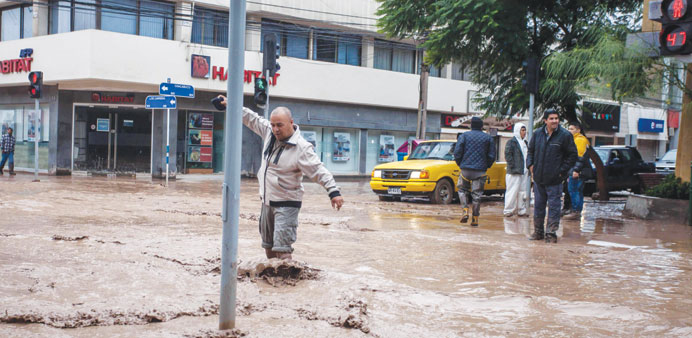Reuters/Santiago
The death toll in Chile rose to four after rains battered the north and caused flooding, the government said yesterday, while 22 others were unaccounted for as the military rescued stranded villagers.
The downpours in the usually arid region have been the heaviest in about 80 years, although the worst of the bad weather appeared to be over, meteorologists said.
Rivers have burst their banks, flooding towns, making roads impassable and forcing miners in Chile, the world’s top copper exporter, to suspend operations.
Chile, caught on a sliver of land between the Pacific Ocean and the Andes Mountains in one of the world’s most seismic zones, is used to dealing with natural disasters.
Military helicopters flew in supplies and evacuated residents from three villages in the Atacama region that were entirely cut off and only reachable by air, Mahmud Aleuy, the deputy interior minister, said yesterday morning.
The city of Copiapo, some 800km north of Santiago, is also partly cut off, he said, adding that the airports of both Copiapo and Antofagasta further to the north have been closed to commercial air traffic.
The government’s ONEMI emergency office reported that nearly 61,000 people were without power and almost 50,000 lacked drinking water in the usually arid regions of Coquimbo, Atacama and Antofagasta.
Television images and photos on social media websites such as Twitter showed muddy rivers rushing through city streets, bridges washed away, flooded buildings, including a hospital, and even some towns that had been partially wiped out.
Onemi said that one person in Antofagasta was electrocuted on the street, while a mudslide killed another person in Atacama. Another 22 people were missing.
The unusual weather phenomenon was caused by a cold front hitting the Andes. Spurred by high temperatures, it produced strong rains at the high altitudes instead of snow, which swept down to valleys and towns in the foothills.
President Michelle Bachelet travelled to the affected areas to assess damages and help lead rescue efforts.
“We’re doing everything humanly possible to get to where (those affected by the catastrophe) are as quickly as possible,” Bachelet said.
Interior Minister Rodrigo Penailillo said that a state of catastrophe had been declared and armed forces had been ordered to co-ordinate support operations and take control of public order in the worst affected area.
The scenes contrasted with those of parched fields further south, which were desperate for rain after a hot, dry summer that hurt farming and mining production.
But the rains fell in a different part of the country and did not signal the end of an eight-year drought, said climatologist Claudia Villarroel.
“These rains serve to accumulate water, but the superficial run-off is very high. What is best is a little, constant rain,” she said.
Firefighters in the south of Chile are battling nearly 40 separate blazes that are burning some 14,000 hectares.
The China Muerta reserve and the Conguillio national park, revered for its forests of thousand-year-old Araucarias, or monkey-puzzle trees, are among the areas affected by the flames.

A man wades across a street flooded by the river Copiapo overflowing after heavy rainfall that affected some areas in the city of Copiapo, Chile.


